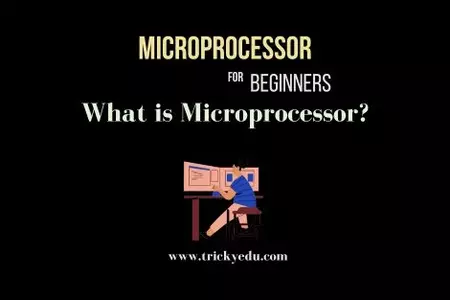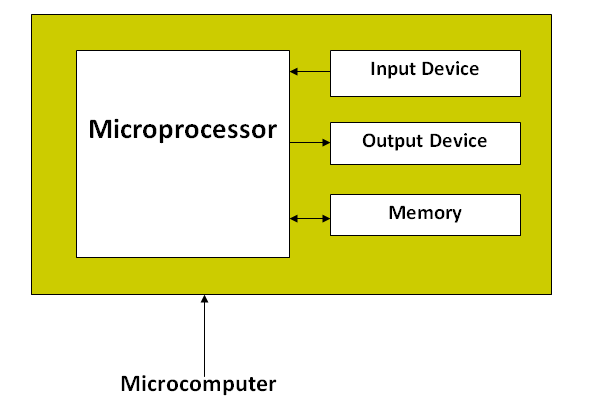Today, we will discuss, What is a microprocessor? The microprocessor has the capability to make a decision.
The device (mobile, laptop, and computer) you are using to read this article has a microprocessor. Without a microprocessor, any electronic device is just like a plastic box.
Microprocessors are used in everything from geysers in the bathroom to microwaves in your kitchen.
We always hear that the microprocessor has the capability to make a decision.
Do you, ever wonder where the ability to take decisions by a microprocessor came from? Didn’t think, it is not a human, it’s a processor. With the help of programming, we have given decision-making capability to a microprocessor.
Table of Contents
Evolution of Microprocessor
Intel 4004 μp was the first μp introduced by the Intel Corporation in 1971. After that 4040 μp was introduced. Intel 4004 and 4040 is the 4-bit μp.
Intel Corporation introduced P-MOS technology-based 8-bit μp i.e., Intel 8008 in the year 1972. This μp is slow.

In 1973, Intel introduced NMOS technology-based 8-bit μp i.e., 8080. Its speed is good, but it needed three power supplies.
Also Read: Addressing modes of 8085 Microprocessor
In 1975, Intel introduced the 8085 μp. Which is based on NMOS Technology? This processor is based on a single +5V power supply. This processor is still used in the laboratory for students’ training.
Intel 8086 μp was introduced in the year 1978. It is a 16-bit μp.
After the development of Intel 80186, Intel 8088, Intel 80188, Intel 80286, Intel introduces a 32-bit μp in the year 1980. Intel introduced a powerful 32-bit processor in the year 1985. And It is widely used in desktop computers. From the below mention table, you can read about the evolution of μp.
| Microprocessor | Year | Word Length (bit) | Remarks |
| 4004 | 1971 | 4 | First μp |
| 8085 | 1976 | 8 | 8-bit μp |
| 8086 | 1978 | 16 | 16-bit μp |
| 8088 | 1980 | 8/16 bit | Used in PC/XT |
| 80286 | 1982 | 16-bit | Used in PC/AT |
| 80386 | 1985 | 32-bit | MMU on Chip |
| 80486 | 1989 | 32-bit | Consists of MMU, cache |
| Pentium | 1993 | 32-bit | |
| Pentium Pro | 1995 | 32-bit | Data Flow processor |
| Pentium II | 1997 | 32-bit | MMX Technology |
| Pentium III | 1999 | 32-bit | Improved version of Pentium II |
| Pentium 4 | 2000 | 32-bit | Improved version of Pentium III |
| Itanium | 2001 | 64-bit | 64-bit EPIC |
How to Communicate With Microprocessor?
we need to communicate with the computer to get our work done. The computer understands only one language, which we call machine language. What is machine language and what is assembly language? Why don’t we use machine language in programming?
The computer understands only one language, which we call machine language. In this language, only two digits are used 0 and 1. These are called binary numbers. The computer only understands this language.
For example: MVI A, 05H
This instruction says copy 05 data into register A. The opcode of this instruction is 3E. If we want that microprocessor to understand this instruction, then we have to write it in binary form (00111110). It is fine for an instruction to remember the 8-bit opcode but it is very difficult to remember the code of the 256 instruction.
Whatever instruction is written using the English alphabet, we call them assembly language. This language is easy for the user to remember. These instructions are called mnemonics.
But the question arises that the microprocessor only understands machine language. So what about Assembly Language? This language is for humans. So that’s why these instructions have a hex code, which we also call opcode.
All the instructions are stored in memory. Whenever we give an instruction to the microprocessor, the microprocessor fetches that instruction from memory and then executes it.
After all, what is decoding? Already all instructions in memory are in binary form. For instance,
Output=a+b; High Level Language
ADD B; Assembly Language
011001011; Low-Level Language or machine Language
If you write the program in a high-level language, it goes to the compiler. Suppose, if you write the program is in assembly language, then the program is going to the assembler.
A compiler converts high-level language programs into machine language but an assembler converts it into machine language and stored it into memory.
Steps of Microprocessor Process
The process of converting programs written in assembly language or high-level language to machine language or binary format is called decode.

The microprocessor that operates based on instruction, we call it execution.
The combined process of fetching, decoding, and execution is called the instruction cycle.
What is Word Length?
Word length tells about the size of the microprocessor. The size of μp is depended upon the size of the ALU (Arithmetic Logical Unit) and the General-Purpose register.
For instance: Because 8085 μp processes 8 -bit data at a time. If data is more than 8-bits then the processor process the first 8-bits then processes the next 8-bits. Similarly, 16-bit μp has 16-bit ALU and a general-purpose register. So, it can handle 16-bit data at a time.
Difference Between Microprocessor and Microcomputer
When we read about microprocessors and microcomputers, we often think that microprocessors and microcomputers are the same things or different. Let‘s find out what is the difference between microprocessors and microcomputers.
The microprocessor is part of the microcomputer. A microcomputer consists of memory, I/O device, and a microprocessor.
A microprocessor is a very important part of a microcomputer. Programming provides decision-making capability to a microprocessor. Notebooks, computers, and laptops, etc. are microcomputers.

What is the Difference Between Microprocessor and Microcontroller?
When we integrate the I/O device, memory, and microprocessor on a single chip, we call it a microcontroller.
List of Various Microprocessor Applications
The microprocessor has many applications. No electronics device can work without a microprocessor. Any gadget without a microprocessor is like a human without a heart. Let’s know about the applications of the microprocessor,
- Mobile Phones (For instance, Android, iPhone)
- Laptop, notebook, and computer
- Traffic light controller
- Smoke Detector
- Kid’s Games
- In Blood Pressure Measurement Machine
- For Temperature Measurement
- In Printers
- LCD TV
- Microwave Oven
- Washing Machine
- In Geyser
- In the Chemical plant to collect data, indications, and measurements.
- Embedded Systems For instance Robots etc.
- Refrigerator
- Power Train
- Electricity Meters
- Water MEter
- Gas Meter
- In GPS System
- Lightening System
- Sensors, For instance, humidity, speed, moisture, etc.
What is Arduino?
Arduino is not a microprocessor. This is a board, on which you can set up a device by installing other components. I would like to tell you one more thing that it is not a microcontroller either.
Latest Core Processor
Core i9 processor
I hope you understand what is a microprocessor? But if you have any problems, then let us know by commenting in the comment box. And if you want information on any other topic, then write to us in the comment box or email and tell us.
